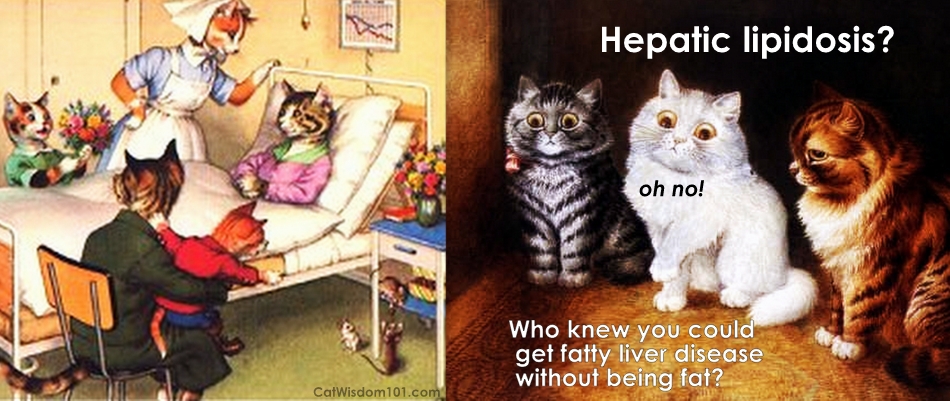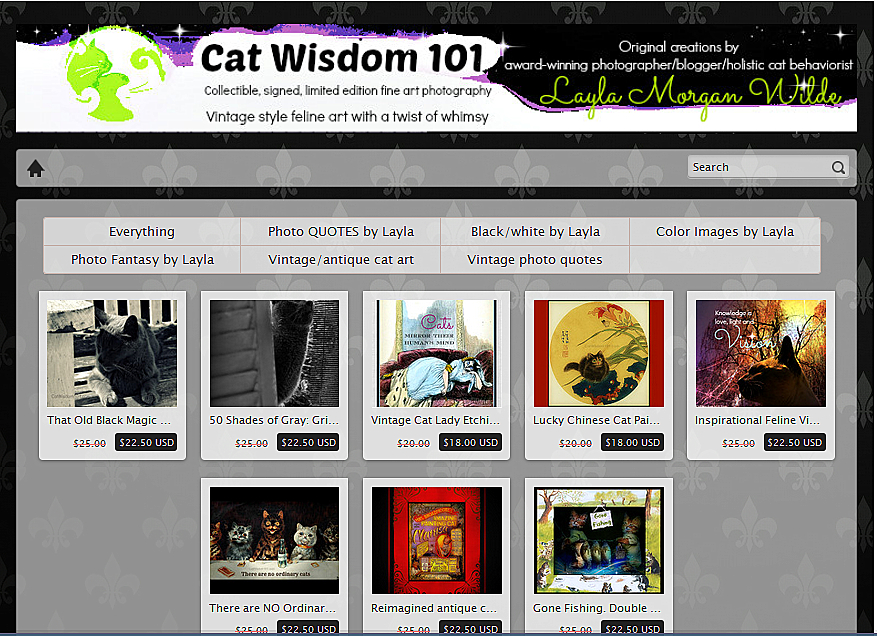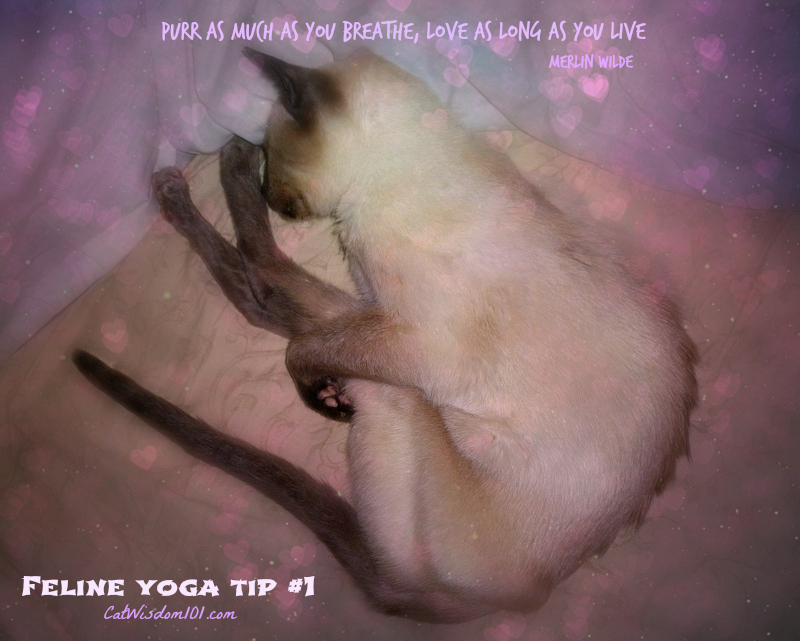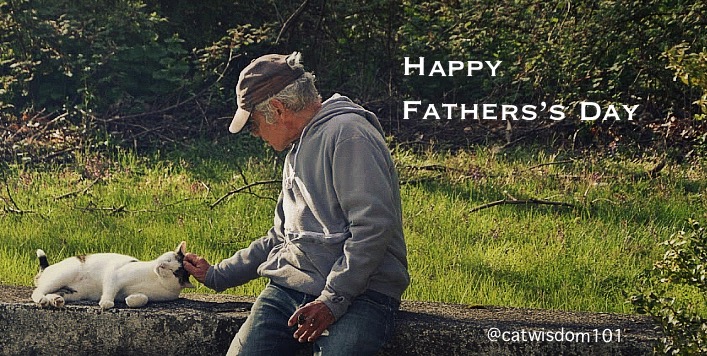
The Sneaky Summer Disease: Feline Hepatic Lipidosis
 Record summer temperatures in North America this year are increasing the risk of a sneaky disease in cats: Fatty liver disease or Feline Hepatic Lipidosis.
Record summer temperatures in North America this year are increasing the risk of a sneaky disease in cats: Fatty liver disease or Feline Hepatic Lipidosis.
Our guest post today is by registered vet tech Georgia Barbush who also makes awesome eco-friendly pet products.
As the summer heats up, many of us with furry family members are well aware of health risks commonly associated with the season. We protect our animals against fleas, ensure they are well hydrated, and watch carefully for signs of heat stroke. But an often overlooked hot weather danger is poor appetite, which puts cats at risk of developing hepatic lipidosis or fatty liver syndrome.
What Is Hepatic Lipidosis?
Cats’ digestive systems are built to take in a few small meals each day. They are not well developed for periods of fasting. When food intake is significantly reduced or eliminated, a cat’s body will use fat stores for energy. Unfortunately, cats do not process fat very efficiently. The feline liver can quickly become overwhelmed with the fat cells the body is trying to metabolize, resulting in hepatic lipidosis.
The liver is responsible for a wide array of critical body functions, including producing important blood proteins and clotting agents, breaking down toxins into less harmful compounds, filtering harmful bacteria and chemicals from the blood, storing iron, and producing proteins needed for immune function.
When the liver is compromised, many body functions are seriously affected and a cat’s health can deteriorate quickly. Fortunately, cats suffering from hepatic lipidosis have a very high survival rate as long as the syndrome is caught in its early stages and the underlying cause is treatable. Hepatic lipidosis can result from any condition that inhibits a cat’s appetite. Hot, uncomfortable weather can cause many cats to experience poor appetite, but it is only one of many possible explanations. Other common causes include stress, overzealous weight loss regimens, or underlying liver disease.
What Does Hepatic Lipidosis Look Like?
More important than recognizing specific signs of hepatic lipidosis is recognizing changes in your cat’s food intake.If your cat has gone just one or two days with little to no food, that is reason enough to contact your veterinarian. This syndrome is best treated before signs of liver dysfunction ever become evident.
Early signs of hepatic lipidosis include:
- slight weight loss,
- excessive salivation,
- digestive upset,
- and dehydration.
Two Ways you can check your cat’s hydration level
1) First, take the skin between your cat’s shoulder blades and gently pull up to form a “tent.” When you let go, the skin should spring right back into place; if it takes a second or two, then your cat is likely dehydrated. It is important to note that this test is not as reliable for obese cats (who can appear more hydrated then they are) and very thin cats (who can appear less hydrated then they are).
2) The second test, if your cat will tolerate it, is to feel their gums for moisture. A well-hydrated cat will have smooth, moist gums, while a dehydrated cat’s gums will feel tacky and dry.
In its advanced stages, hepatic lipidosis will cause extreme weight loss. Cats in this stage will also develop a condition called icterus, which means yellow coloring to the mucous membranes, skin, and white portion of the eyes. The liver’s failure to filter toxins from the blood can also affect the nervous system, leading to seizures. Any animal exhibiting these signs is in severe need of immediate veterinary care.
How Is Hepatic Lipidosis Treated?
Treatment consists primarily of reintroducing food and correcting dehydration and electrolyte imbalances with IV fluid therapy. In most cases, a feeding tube will need to be placed in the stomach via the nose. While vital signs and overall condition are closely monitored, special food developed for critical care patients will be administered through the feeding tube in carefully measured amounts. Once stable, the patient may go home with the feeding tube still in place. The feeding tube can be removed when the cat’s appetite has returned to a normal, healthy level.
Is Your Cat At Risk?
While obese cats over 7 years old are most commonly affected, any cat has the potential to develop hepatic lipidosis. Obese cats are at greater risk simply because they have more fat stores available to overwhelm the liver. No matter your cat’s age or body condition, it is always important to be observant of appetite, weight, general behavior, and attitude. Catching minor changes can make all the difference in the success of treating this condition and many others.
What Can I Do to Prevent Hepatic Lipidosis?
Some causes of hepatic lipidosis are, sadly, beyond prevention. Fortunately, there are many ways to minimize your cat’s risk of developing this syndrome. One of the most effective is to ensure your cat maintains a healthy weight. If your cat is currently overweight, discuss a safe, long term weight loss plan with your veterinarian and observe your cat closely for dangerously rapid weight loss. Also, keep track of how much your cat is eating and consult your veterinarian should a decline in appetite occur.
In the summer months, be sure to provide a cool, comfortable area for your cat to seek relief from the heat. Offering healthy frozen treats like small cubes of pumpkin puree, plain yogurt, or wet cat food will also help your cat stay cool and encourage appetite.
Minimizing the risk factors and recognizing the early signs of hepatic lipidosis are your best means of defense against this highly treatable but potentially fatal syndrome.
Ever wonder what the vet tech does with your cat? Or have a Vet 101 question? Email it to info@catwisdom101.com with Vet 101 in the subject line.
We’d love a vote from YOU. Cat Wisdom 101 is a Pettie Award finalist for Best Cat Blog. Voting is on until July 31. You can vote once daily and every vote counts! Click on the link and VOTE. This contest has expired.







15 Comments
Kitties Blue
This is such a great post. I had never even heard of this disease until I started blogging. Thanks also for listing symptoms and causes. Purrs and hugs, Lily Olivia, Mauricio, Misty May, Giulietta, Fiona, Astrid, Lisbeth and Calista Josette
CATachresis
Thanks Layla, another very informative post!
Sue Brandes
Never heard of this before. Thank you for the informative post.
MizzBassie
Great description of a scary disease. Thank you for the information. Purrrrrrrrrrrrrrs.
Abby
We had read about this before but this was very easy to follow and understand thank you for the information.
Brian
Well we are good here but I had no idea about that at all!
sayumi kamei
That’s a great info on diet, nutrition and various ways to take care of liver and other vital parts of the cat’s body. Our cat Neko has been with us for 22 years. Recently he suffered a stroke, and paralyzed most of his body. The vet determined that it was time to let him go. But Neko was not about to give up. Through our love, determination and his endurance, he has now almost fully recovered very quickly. Please watch this amazing video of his journey.
The courage of a cat
Jacqueline
Great, informative post!…Have a fun day, precious friends!…kisses…Calle, Halle, Sukki, Mommy Cat, Daddy Cat
da tabbies o trout towne
manee thanx gris N crew for thiz post….we dinna noe crazed weather could cause this disease….N manee thanx for de dehydrashunz tip….sum kittehz gonna get “tested” on that two nite !!
The Island Cats
This is great info! We never thought the hot weather could cause this.
Kathryn
Wow, scary and helpful. i will tent Ched’s skin and look at his gums. He doesn’t drink as much as Mao. i myself have had to go on Gatorade daily because of all this heat.
Sometimes, Cats Herd You
We’re glad to see more information about hepatic lipidosis getting attention. It’s one of those conditions that people don’t know to watch for, and the more education, the better!
Matt - Brisbane Photographer
Thanks heaps for the detailed description – we’re heading into summer at the moment so I will keep a close eye on my kitties!
Layla Morgan Wilde
Matt, is you’re down under, aren’t you in winter?
Layla Morgan Wilde
Matt, if you’re down under, aren’t you in winter?